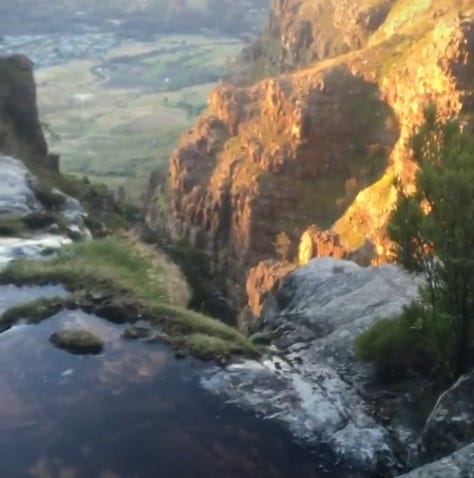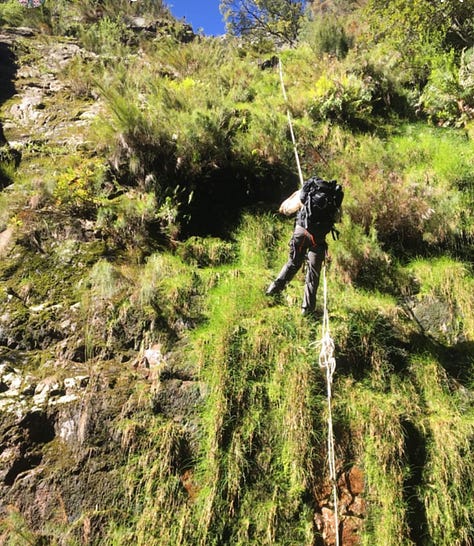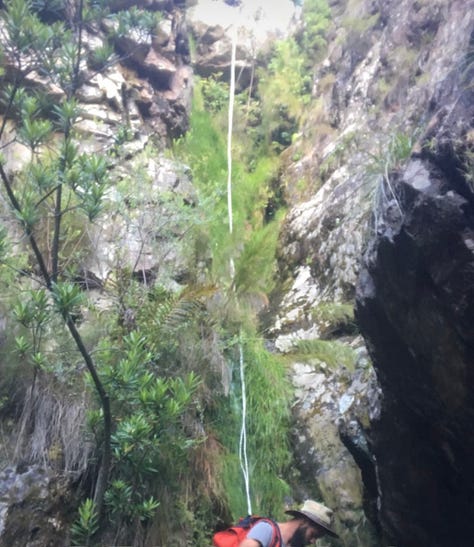A Wild and Dangerous Beast Is Wooing Me.
Part 1. Context of a new language.



It’s 2 pm, and we are unaware of how consequential the decision we are about to make will be. Earlier this morning, two friends and I set off on a hiking adventure consisting of a five-hour steep hike up a mountain, followed by rappelling/abseiling down sixteen waterfalls and cliffs, each between 12 and 80 meters high. We began our climb at 8 am, a bit later than we hoped, at the foot of the majestic Stellenbosch mountains.
The way up was a beautiful but grueling hike. A cool breeze was the perfect accompaniment to our physical exertion. The most exquisite views awaited us on the mountain top. We found a spot to enjoy our lunch, and it seemed as if the natural beauty and food massaged our fatigue away. After lunch, David, the most experienced mountaineer among us, suggested that we might have to return the way we came, as it was a bit late to start the rappelling descent. Once you rappel down, you cannot go back up. It’s a one-way route. However, we put the decision to a vote, and Roann and I both wanted to continue. Who wants to hike the same route again if a new experience beckons?
Because the route is rated as extremely difficult, few people attempt it. Consequently, there were no clear paths – the terrain was wild. It took us longer than we hoped to find the first rappelling site, but wow, what a stunning location! Rappelling down in cold mountain water was exactly what our bodies craved after the hot and sweaty hike up. Yet, simultaneously, we had to give each movement our attention as the cliffs were slippery, and a wrong move could result in serious injury. Amidst such beauty, intimate immersion in nature, and intense attention to detail, it is easy to lose track of time.
It was after the fourth waterfall descent that one of us noticed the time, while taking a photo with his phone. 6 pm! There were only two hours of daylight left, and no way we would make it down in time. Realizing this, we tried to phone our wives and let them know the situation, but we had no reception. With renewed urgency, we made our way down another two waterfalls. I noticed myself shivering as the evening air, high up in the mountains, turned icy, and being wet only made it worse. None of us brought warm clothing. Thankfully, we each had a thin t-shirt/pullover in addition to the wet shirts we were wearing.
We decided to push on as far as we could in the hope of getting cellphone reception and shelter from the icy wind. The next two descents were the highest and most difficult – a 40-meter drop onto a small ledge on the wet cliff face, followed by a 60-meter drop into a stream. David and I sat huddling together to resist the icy wind as Roann made his way down. I went next. My descent was synchronized with the setting sun. There was hardly enough room for two people on the ledge. By the time David made it onto the ledge, the evening dusk faded. Occasional clouds hid the stars, resulting in a thick darkness. I could not see my own hand waving in front of my face. As I stood with my back against the cliff in utter darkness, the feeling of exhilaration and adventure gave way to the harsh reality of our situation. What the hell am I doing here! But this was not the time to panic. Finding our way down was a matter of life or death. Feeling our way around the cliff face, we found the bracket on which to attach the rope. This time, I went first. Occasionally, the clouds blew away, letting through some starlight. What it revealed was both stunningly beautiful and frightening. The 60-meter drop abruptly ended amidst jagged rocks in a slow-flowing stream on the side of a thick forest in a narrow gorge. What a relief when all three of us made it down into the stream without any serious incidents. Thankfully, the gorge was not as cold or exposed to icy winds.
Surprisingly, Roann’s phone picked up a faint signal, and we were able to contact family. The time was now 10 pm, so you can imagine how worried they were, having expected us to be back around 6 pm. They wanted to contact the mountain rescue team immediately, but David, having served as a mountain rescuer, knew that there was nothing they could do based on our location. A helicopter would not be able to navigate into the gorge at night, and a land-based team, even if they were to start the journey in the middle of the night, would not reach us before morning. Our best option was to stay put and continue our descent in the morning.
We tried to settle in for the night. No food was left, as we had eaten it all at lunch. There was, however, no shortage of drinkable water. Luckily, someone found some matches in their bag, and we began gathering wood. The fire warmed us while drying our wet clothes, which we hung on nearby branches. Sleeping seemed impossible on the uneven terrain, but then again, we were exhausted. Despite the discomfort, the hunger, the sore muscles, and the prospect of another eight rappelling descents in the morning, I felt at peace and at home. Our ancestors survived and thrived in these situations for millennia.
Then, in the early hours of the morning, David started reeling with pain in his chest. He tried to sit in different positions, drank water, and we prayed, but the pain remained. Not knowing how serious the situation might be, we decided to use the last bit of battery power to phone family and alert them. They mobilized the mountain rescue team, and as the morning light emerged, we heard the rapid rhythmic buzz of helicopter blades.
The helicopter crew surveyed the area for a couple of hours, searching for the safest way into the gorge. I remember that moment when the distant sound became louder and louder, announcing our rescue. The blades seemed to be touching the sides of the narrow gorge as it hovered above us. A rope was lowered, and soon after, a rescuer made his way down with a stretcher. The noise was so amplified in the gorge that we could not hear what the rescuer was shouting, so he just began doing his thing. David was hoisted first, followed by Roann, and me last. The sight of our evening abode from above, as I slowly spun around while being hoisted, stirred a sense of gratitude. The beauty and danger of this natural world are what afford us the opportunity to be fully alive.
David was taken to the hospital immediately, and thankfully, his heart was okay. He made a full recovery in a couple of days.
I learned something about myself during that experience. The adventure of something new, of a path not yet taken, is more appealing to me than the safety of a familiar road. That inclination can be a good thing and a bad thing. It is always our strengths that are our weaknesses. This inclination also shows up in the ideas, theories, and beliefs that intrigue me. I find myself drawn in directions I do not fully understand.
A New Adventure
In my journey of faith, it feels like 2 pm on a mountain top, and I’m unaware of how consequential the decision I’m about to make will be. There is the option to travel back on the same path that brought me here, revisiting the same themes and ideas that are so familiar to my Christian community. However, I must admit that I find the prospect boring. New horizons beckon, wild and untamed.
I’m grateful for the path that brought me here,
but I have no desire to traverse it again.
Its value, accrued in memory,
would be diluted,
should I stumble across it again.
What was once wild and dangerous,
would be made tame, nothing precarious.
I’m grateful for the path that brought me here,
precisely because it did not imprison me
in endless cycles of familiarity.
New adventures beckon.
Themes, topics, terms, and their definitions,
that once were novel,
lose their value if repeated again and again.
I have no interest anymore
in mastering the subject –
what a dull accomplishment that would be.
Instead, I find myself excitedly afraid –
a wild and dangerous beast is wooing me.
I’m drawn by what I cannot grasp,
a mystery unconstrained, uncontained.
I have no interest anymore
in mastering the subject – what a dull accomplishment that would be.
Instead, I find myself excitedly afraid –
a wild and dangerous beast is wooing me.
I’m drawn by what I cannot grasp,
a mystery unconstrained, uncontained.
In my spiritual journey, “the path that brought me here” refers to the language and the sources, primarily Bible narratives, that guided me on that journey. I’m grateful for that path, but simultaneously, I find myself completely disinterested in traversing those themes again. Hearing another exposition on “justification by faith” has no appeal. I’m sure Jesus himself rolls his eyes when he hears yet another interpretation of what he meant with: “It is finished!” I’m very aware that these phrases are precious to many – they are to me as well. The point is that we cheapen the value and meaning they refer to when we repeat the same old rhetoric without connecting to the heart of the matter and finding its relevance to our place and time. We must find new metaphors to invite our world into this living reality.
Some experiences need time to find appropriate words – language that does not confine the experience but moves with it. There are a few of these experiences that I have been hesitant to share, not wanting to reduce the life-giving event to static terms. But the time has come. I might have found the appropriate words to communicate more than a concept – to extend an invitation into a living experience. To feel the essence of this invitation, we have let go of the tame and domesticated language of our religious traditions.
Larger than our Religion and Tradition.
This is not a “falling away” from the faith, but a continuation of what always happens when encountering a God that is larger than our religion, our culture, and our tradition. Divine encounters lead to expansion – expansion in perception, experience, the sources we learn from, and the traditions we expose ourselves to.[1] Even Jesus learned that our religious traditions could become obstacles rather than guides in this journey. (Matthew 15:6)
We read about figures such as Abraham and imagine that these heroes of faith had their shit together: they knew what they believed and pursued their goals single-mindedly. However, if we attentively read their stories, we’ll see that they were more like us than we imagined. They found themselves drawn in directions they did not fully understand. Prophets found themselves thinking and speaking a message so counter-cultural, so contrary to current religious rhetoric, that dramatic events followed. On occasion, the whole community was transformed; on other occasions, the prophet was killed. (Hebrews 12:32-39) Although a good outcome was not guaranteed, they followed the inclination of their hearts with integrity.
Finding new language, new sources, and new images to draw us towards new horizons, is not popular with those who have mastered the old language and its familiar ideas. I’ve often been challenged for using philosophical ideas in speaking about spiritual matters. The criticisms can be boiled down to the strange notion that theology is divine, and philosophy is human – that we encounter divine revelation in theological concepts and inferior man-made ideas in philosophy! I can only laugh at such arrogance.
Appreciation and Explanation.
Theology can be done in two ways. First, in understanding the philosophical assumptions on which our theological ideas are founded. Second, in ignorance of the philosophical assumptions on which our theological ideas are founded. Whichever way, we cannot avoid philosophical assumptions. It also comes as a surprise to those who criticize the mixture of philosophy and theology that the biblical writers made no distinction between these disciplines. The separation into distinct categories of knowledge came much later. The separation had advantages and disadvantages, but that history is beyond the scope of what we’ll explore today. Instead, I’ll highlight one advantage - a distinction that is helpful to me is that theology is the language of appreciation and philosophy is the language of explanation. They overlap but have a greater involvement with either appreciation or explanation, respectively.
There is no such thing as a pure theology from above – statements from God’s perspective. Even if God took the initiative to reveal Godself, whenever we understand or speak of that revelation, it happens via the process of interpretation. Whenever you think or speak, it is from your perspective … even if you imagine that you are expounding God’s perspective. And that’s not a bad thing! There is something unique and beautiful about every perspective. It only turns bad when one loses touch with reality and considers one’s own finite perspective as the whole truth. The very concept of “God’s perspective” is problematic because the One who is present in all does not have a perspective.
All of that to say, I have found myself drawn, intrigued, and surprisingly moved by extrabiblical ideas and sources. The insights gained there have hugely influenced my experience and faith. In the coming weeks, we’ll (Mary-Anne and I) publish articles, sharing some of these transformative paths – new paths – paths on which we hope to find fellow adventurers.
[1] The scriptures themselves are not shy in referring to other literary works for validation and inspiration! References include: “the Book of the Wars of the Lord” (Numbers 21:14) and “the Book of Jashar” (2 Sam . 1:18). More than 20 external sources are mentioned by name in the Old Testament alone, all of which are lost to us. Paul, while declaring that God wants to be found in the uniqueness of every nationality, shamelessly quotes a pagan philosopher: “For we are also His offspring.” (Acts 17:28)


I'm eager to see where you go!
“The very concept of “God’s perspective” is problematic because the One who is present in all does not have a perspective.” Wow what a statement! Thanks for sharing. I’m excited to see what paths you clear for us!